Episodes
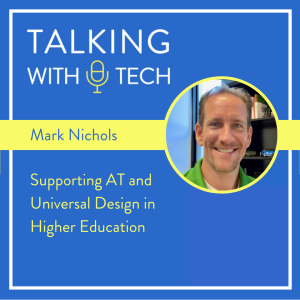
Wednesday Jul 07, 2021
Wednesday Jul 07, 2021
This week, Chris interviews his long-time colleague, Mark Nichols, an AAC/AT Specialist who is the Senior Director of Universal Design and Accessible Technologies at Virginia Tech. Chris and Mark talk about the differences and similarities between higher education and K-12 for universal design and AT, the types of technologies that are often very useful in higher education, how to determine how much a university supports inclusion and assistive technology, and more!
Before the interview, Chris shares memories and thoughts about the late, great Joy Zabala with his wife, Melissa Bugaj. They talk about the importance of Joy’s SETT framework, the impact Joy had on AT, and Melissa and Chris’s personal relationship with Joy and how she influenced their personal life.
Key ideas this week:
🔑 You can set up software to identify how inclusive your materials are. Software like Grackle for Google Docs (grackledocs.com) will scan a document to determine if there are accessibility issues (e.g. a pdf image that does not support text to speech) before the document is posted.
🔑 Accessibility and universal design are not just for a select set of people with disabilities - many times, typically developing students will benefit from making materials more accessible. Also, making the solution universal students don’t have to ask for the tool to have it available.
🔑 Consider making a training video for staff that outlines all the ways that universal design and accessibility can make a big difference for students and then gives training on how to use the technology services currently available to make more accessible materials.
Help us develop new content and keep the podcast going strong! Support our podcast at patreon.com/talkingwithtech!
Visit talkingwithtech.org to access previous episodes, resources, and CEU credits that you can earn for listening to TWT episodes!
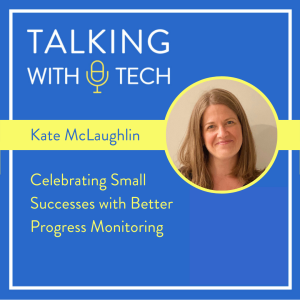
Wednesday Jun 30, 2021
Wednesday Jun 30, 2021
This week, Rachel interviews “The AAC Coach” Kate McLaughlin! Kate and Rachel discuss resetting our expectations surrounding what progress looks like for AAC users, the importance of layering small AAC habits over time to get big results, how to create more effective goals for AAC users, and more! This episode is packed with lots of practical ideas and tips – you won’t want to miss it!
Before the interview, Rachel and Chris talk about Rachel’s recent Hawaii vacation and respond to an email sent in by a Patreon subscriber. This subscriber is looking for help being more effective, because she feels like she is stuck having the same conversations and coaching the same strategies over and over again.
Key ideas this week:
🔑 Don’t focus so much on the device that we lose sight of meaningful progress. If the goal for an AAC user is successful communication and as much autonomy as possible, we should celebrate any steps toward autonomous communication, regardless of whether the device was used or not. The focus should be on building connections with others and not on a particular modality.
🔑 Many AAC users make slow gains. If we switch the AAC program and symbols prematurely due to “lack of progress” then the AAC user may never make significant gains. Celebrate the small wins and try and measure progress in a way that shows meaningful growth.
🔑 Layering small AAC habits over time can lead to big changes. When a family starts with an AAC system, they can take time to get comfortable – e.g. start with carrying the device around everywhere. We want to build fluency and naturalness using the system and not let the device disrupt connection between the communication partners.
🔑 When writing goals, we should write them so we can track progress in a meaningful way. Communication should be for real reasons. There is a lot of pressure on therapists to write goals that are easily tracked in contrived communication settings. Instead, write goals that look at the AAC user’s participation in shared activities - also consider different settings and/or different people.
Help us develop new content and keep the podcast going strong! Support our podcast at patreon.com/talkingwithtech!
Visit talkingwithtech.org to access previous episodes, resources, and CEU credits that you can earn for listening to TWT episodes!

Wednesday Jun 23, 2021
Wednesday Jun 23, 2021
This week, Chris interviews Meryl Schnapp & Mark N. Brown, AAC Implementation Coaches with Chicago Public Schools. They discuss how the position of AAC Coach was created in their district, why it is so helpful having coaching as a separate position in a school district, what they have learned from instructional coaching research, and more!
Before the interview, Chris talks with Rachel about participating in the recent Greatest International Scavenger Hunt (GISH) mini-hunt. Chris shares some of the unique activities Chris and his family did on their GISH hunt. Chris and Rachel discuss ways that these types of scavenger hunts could be used to make AAC coaching more fun for AAC users and communication partners.
Key ideas this week include:
🔑 AT Specialists and AAC Coaches have different roles in Chicago Public Schools. The AT Specialists engage in device selection and training, and after the training the AAC Coaches collaborate with staff to implement the device effectively in the classroom.
🔑 In the education field, instructional coaching is a well established form of professional development with a large evidence base. Mark and Meryl were exposed to literature from researchers like Jim Knight and Michael Bungay Stanier to help develop Chicago Public School's current approach.
🔑 In Chicago Public Schools, students aren't the only ones who have goals! Some teachers and SLPs have self-created goals to help improve their skills supporting AAC users.
🧑💻👨🏫 Meryl Schnapp and Mark N. Brown have a FREE AAC in the Cloud presentation about AAC coaching on June 24th at 6:00 pm EST .
🧑💻👨🏫 Chris also has a presentation at AAC in the Cloud on June 24th at 2 pm EST - its about interactive choose your own adventure games!
Help us develop new content and keep the podcast going strong! Support our podcast at patreon.com/talkingwithtech!
Visit talkingwithtech.org to access previous episodes, resources, and CEU credits that you can earn for listening to TWT episodes!
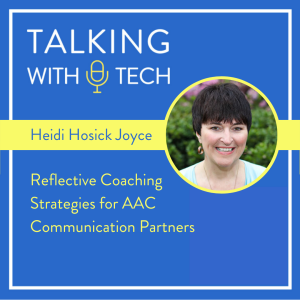
Wednesday Jun 16, 2021
Wednesday Jun 16, 2021
This week, Chris interviews Heidi Hosick Joyce, an SLP and specialist in both AAC and Autism Spectrum Disorders. Heidi and Chris discuss some of the differences between coaching in sports and coaching AAC communication partners, including "reflective coaching" - helping someone to change what they are doing at the level they are capable of. They talk about the importance of building a positive relationship, giving positive reinforcement, and using "I wonder" phrases to encourage self-reflection amongst communication partners. Heiti also discusses PACT, a “low dose” therapy method that includes therapists using video to coach care givers how to support their autistic child’s social communication at home and in the community. Find out more here. Heidi also shares about her survey for SLPs who support AAC users - learn more at redcap.link/AACtraining
Before the interview, Chris discusses his upcoming session for Closing the Gap with Shaun Pearson and Katie Robertson called "Voice and Choice -- Learning Made Fun Through Interactive Choose Your Own Adventure Games". This session will focus on all the ways that generative language and core words can be encouraged playing "choose your own adventure" games. Rachel shares a strategy for logging an AAC user's spontaneous language - you can use a virtual assistant (e.g. Alexa, Google Home) to create a communication log all day long whenever communication occurs.
Key ideas this week include:
🔑 Help communication partners to reflect on what they did when working with the student - there is a temptation to focus only on what the student is doing.
🔑 One reason "consulting" doesn't work is because you don't always have the context to totally understand something you witness. Feedback based on incomplete information can cause interpersonal problems and lead to incorrect advice.
🔑 Use videos. When something is going well, you can send to parents. Then your example can act as a training model for them (e.g. longer wait time).
🔑 We can better move the needle towards AAC proficiency if the family and school staff understand where an AAC user's language level is at, meet them there, and push them to improve to the next level.
Help us develop new content and keep the podcast going strong! Support our podcast at patreon.com/talkingwithtech!
Visit talkingwithtech.org to access previous episodes, resources, and CEU credits that you can earn for listening to TWT episodes!
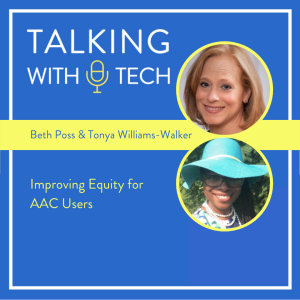
Wednesday Jun 09, 2021
Wednesday Jun 09, 2021
This week, Chris interviews Tonya Williams-Walker and Beth Poss about improving equity for AAC users. Tonya is an Instructional Specialist, AAC Specialist, AAC professor, and SLP. Beth is an author, SLP, AAC Specialist, and Director of Educational Programs for LessonPix. Beth, Toyna, and Chris discuss the meaning of equity, how equity is different from equality, ways that we can improve equity for AAC users, and how they have adjusted their own practices to confront biases surrounding people with complex communication needs.
Before the interview, Rachel and Chris discuss some of Rachel's concerns with the amount of time that some SLPs are prioritizing working on verbal speech when they work with young children with limited speech skills. Rachel is working with 8 and 9 year olds who have only worked on verbal speech for 5 or 6 years. Ethically, its an SLPs responsibility to build the foundation for language development, and if verbal speech isn't working, SLPs need to either introduce AAC or refer out to an AAC specialist who will.
Key ideas this week:
🔑 When looking at whether a young child (e.g. 3 years old) is a good candidate for AAC, look at imitation and approximation skills. If those skills aren't there, we should have the conversation with the family about language development and giving their child "visual supports" or robust AAC to build comprehension and alleviate frustration.
🔑 Listen to all the ways that AAC users are communicating with us about their systems, what is important to them instead of imposing on them what we think is best. To listen better, Tonya asks AAC users and families "What do you need in order to feel successful?" and then "How can I help?".
🔑 "Equity" is not the same thing as "equality". Equity can mean supporting people who have been disenfranchised more than others so they can get to a place where they have the same access, power, and opportunities as everyone else.
Help us develop new content and keep the podcast going strong! Support our podcast at patreon.com/talkingwithtech!
To listen to this episode, search "Talking with Tech" in your podcast player of choice or go to www.talkingwithtech.org/episodes/poss-and-williams-walker
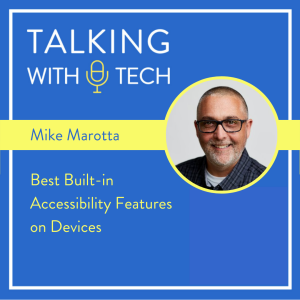
Wednesday Jun 02, 2021
Wednesday Jun 02, 2021
This week's interview is with Chris's long-time friend and fellow assistive technology specialist, Mike Marotta. Mike is a specialist in inclusive design, and he joins Chris to discuss how accessibility features for common devices like iPhones, iPads, Chromebooks, and Android phones can be used to meet assistive technology needs. They talk about which features they like the most, adding captions, universal logins for accessibility, how to decide on which tools to offer people, and more!
Before the interview, Chris and Rachel discuss ways that accessibility has been improved in the past year despite the pandemic, including Instagram adding automatic closed captioning for videos. Rachel discusses reaching out to technology companies for help with an accessibility issue, such as when she asked makers of the Word Wizard app to add high contrast.
Key ideas this week:
Many "accessibility" features on our devices are not just for people with access problems (e.g. vision problems). Features like text to speech are helpful for many people - it can help everyone proofread their writing, for example.
Captions are a great way to promote literacy and draw learners in. You can even mute the TV audio to require learners to read to follow the story.
We don't want to overwhelm people with too many assistive technology tools. Work with the learner's team to dig into what the real issues are and then decide on one or two tools that will address those issues. You can always add more tools later as they become more proficient.
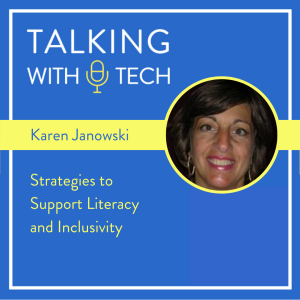
Wednesday May 26, 2021
Wednesday May 26, 2021
This week, Chris interviews Karen Janowski! Karen is an inclusive technology and assistive technology specialist who is also co-author of Chris’s new book, Inclusive 365. In the interview, they discuss some of the many ways that we can support literacy for all and make classrooms more accessible to all students (e.g. audio supports, digital texts that can be read aloud, etc).
Before the interview, Chris shares about a former student he has worked with who is moving to a new situation that does not support robust AAC. Chris discusses why this was such a disappointment, and how this experience motivates him to better support the students that he works with now. Rachel talks about the difficulty of supporting students who don’t make progress and/or have AAC taken away from them.
Key ideas this week:
🔑 General education teachers should choose inclusive instructional methods and ways for learners to demonstrate what they know, even if those students are in special ed.
🔑 Student-selected books for reading and self-selected topics for writing are very compelling for learners. Choice can really drive the love of learning. Writing for an authentic purpose (e.g. having learners write a letter asking for support for a cause that is important to them) can be very effective as well.
🔑 Worksheets are a classic example of an instructional output method that is limiting for many students. Worksheets are OK as an option, but we don’t want to require everyone to use them. For example, you could also choose an input option that allows dictation, keyboards, spell check, etc.
🔑 Start your thinking and planning with each learner's strengths in mind. Figure out what learners are best at and what they love to plan activities that are more motivating.
Resources
Book Creator - bookcreator.com
Seesaw - web.seesaw.me
Inclusive 365 book site: inclusive365.com
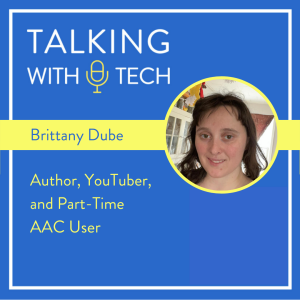
Thursday May 20, 2021
Thursday May 20, 2021
This week, Rachel has an informative and engaging interview with author, YouTuber, dog trainer, and part time AAC user Brittany Dube! Brittany shares about why she is a part-time AAC user, how parents and others can better support part-time AAC users, and how we can show AAC users the respect they deserve in conversation.
Before the interview, Rachel shares a fascinating story about one of her clients who has improved his verbal speech by watching others model AAC, even when the client doesn’t use AAC himself. Its a great reminder that AAC is an excellent tool for teaching language even when it isn’t used by the client to expressively communicate. Rachel also shares the disappointing decision by the school team not to support AAC for this client because the client is “already verbal.”
Key ideas this week:
🔑 All forms of communication should be given equal respect by parents. Parents understand that one-size-fits-all doesn’t work in education and healthcare, but when it comes to communication some only want to pursue verbal speech.
🔑 We don’t have a right to speak for someone just because they use AAC - we need to remember to give AAC users whatever time it takes to speak for themselves.
🔑 Brittany finds using AAC is most useful when she is in an overwhelming situation, like when a doctor is asking her how she feels. Using a device gives her more time to process than she would get using verbal speech alone.
🔑 It’s always important to remember a lack of verbal speech doesn’t mean that the person doesn’t understand - people who use AAC are often intelligent and aware of their surroundings.
You can learn more more about Brittany on Instagram and YouTube!
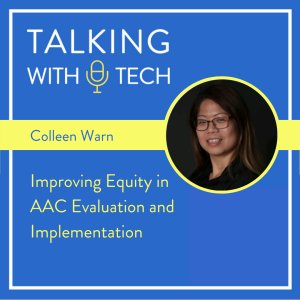
Wednesday May 12, 2021
Wednesday May 12, 2021
This week, Chris interviews Colleen Warn, Director of the Center for Assistive Technology for the NYC Department of Education. Chris and Colleen discuss how we can make assistive technology more equitable, especially for racially/culturally diverse students and students with a lower socio-economic status (SES). They talk about how their Center for Assistive Technology has pushed to teach teachers and staff about AAC, how they have changed the referral process to be more equitable, and how they seek to empower service providers across NYC. Colleen also shares about supporting her child, who has complex communication needs, and how her family has learned more about AAC.
Before the interview, Chris and Rachel talk about their upcoming preconference seminar, “Designing and Delivering Empowering Experiences to Teach Language Using AAC” and their excitement to be able to connect with learners in a more intimate and collaborative environment. Learn more at bit.ly/designaac
Key ideas this week:
🔑 One important consideration when looking at equity in assistive technology is the speed in which a school or district gets an AAC device when they need one. Make sure everyone gets a device at the same speed, regardless of SES.
🔑 If one district or school is sending in many more referrals than other districts, look at the makeup of the students who are not getting referred for AAC and their service providers. Are there cultural or SES barriers to implementing AAC?
🔑 When a related service provider (e.g. SLP) sends a referral to do an AT assessment, consider coaching that person how to do the assessment itself. This will improve their skills and may improve their ability to refer the correct students with AT needs in the future.
Help us develop new content and keep the podcast going strong! Support our podcast at patreon.com/talkingwithtech!
Visit talkingwithtech.org to access previous episodes, resources, and CEU credits that you can earn for listening to TWT episodes!
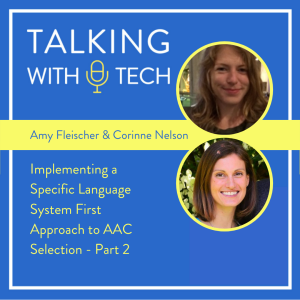
Wednesday May 05, 2021
Wednesday May 05, 2021
This week, we present part 2 of Chris’s interview with Amy Fleischer and Corinne Nelson! Amy and Corinne continue with their questions about changing their district to a “specific language system first” model of device selection, and how it can be adapted to best fit the needs of their school district. They also discuss whether PECS should be a prerequisite for getting a device, ideas for rolling out training on modeling, and more!
Before the interview, Rachel discusses a recent conversation she had with a mother of a person with complex communication needs. This person doesn’t have access to a robust AAC system and was initially given only a switch to communicate with - even though she has no access issues. Rachel questions why so many children she hears about with complex communication needs are being given a switch when no access issues are present. Rachel feels many of her clients have been held back due to myths, such as “an AAC user must show cause and effect with a switch before they can use high-tech AAC.”
Key ideas this week:
🔑 If you are concerned with hesitancy with changing how device selection occurs in your district, you can use a collaborative approach to select the device for a few students, then down the road you can look back and have everyone decide what is best.
🔑 To be more collaborative with device selection, you can take a facilitative, coaching approach to the meeting (e.g. teachers, related service providers). Then, in the meeting, try and fill out a grid or chart that looks at the communication needs of the student and the needs of the circle of support. Focus on long term growth, not just what would be easiest to learn in the short term. If you try device selection with a more collaborative approach, then down the road you can look back and have everyone decide on what worked best.
🔑You can pick one strategy or process to teach modeling, like SMORRES, and adopt it across the district. You can implement this modeling strategy more quickly than moving to a specific language system first model that would take a longer amount of time.
Help us develop new content and keep the podcast going strong! Support our podcast at patreon.com/talkingwithtech!
Visit talkingwithtech.org to access previous episodes, resources, and CEU credits that you can earn for listening to TWT episodes!
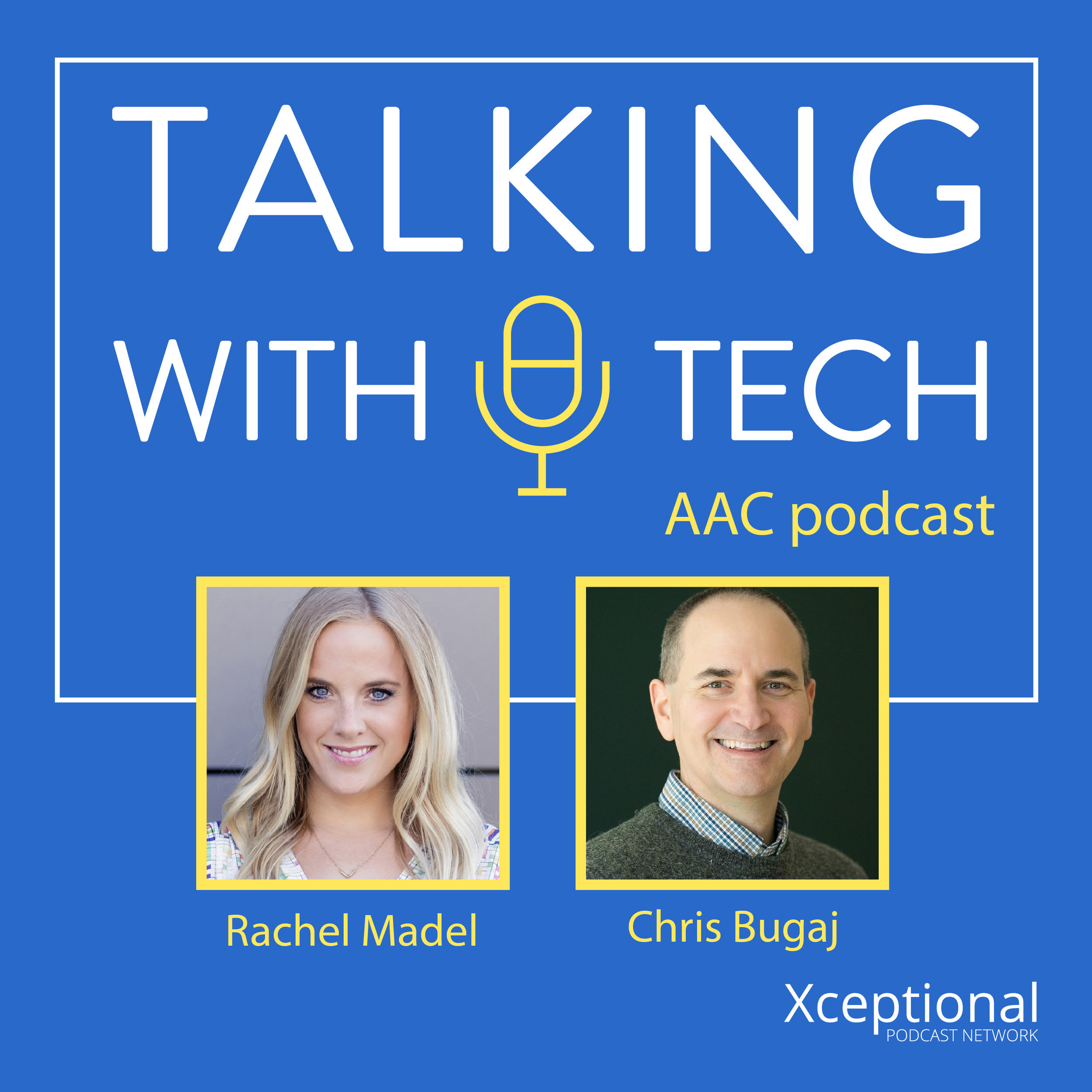
Join AAC experts Rachel Madel and Chris Bugaj as they dive into a weekly discussion about all things AAC (Augmentative and Alternative Communication). Every episode they deliver practical resources, clinical guidelines and relevant research to help clinicians better utilize technology for individuals with complex communication needs.
Episodes include interviews with industry thought-leaders, clinicians, parents, researchers and app developers to keep you on the pulse of the educational technology scene and better support communication through the use of technology.


